Effects of Planting Density and Nitrogen Management on Light and Nitrogen Resource Utilization Efficiency and Yield of Summer Maize in the Sichuan Hilly Region
Abstract
:1. Introduction
2. Materials and Methods
2.1. Experimental Site
2.2. Experimental Design and Field Management
2.3. Sampling and Measurements
2.3.1. Population Light Distribution
2.3.2. Population Dry Matter Accumulation and Radiation Use Efficiency
2.3.3. Nitrogen Uptake and Utilization Characteristics
2.3.4. Analysis of Apparent Soil Nitrogen Losses
2.3.5. Yield and Its Composition
2.4. Statistical Analysis
3. Results
3.1. Effects of Planting Density and Nitrogen Rate on Summer Maize Light Distribution
3.2. Effects of Planting Density and Nitrogen Rate on Summer Maize Grain Yield and Its Components
3.3. Effects of Planting Density and Nitrogen Rate on Summer Maize Dry Matter Accumulation and Radiation Use Efficiency
3.4. Effects of Planting Density and Nitrogen Rate on Summer Maize Nitrogen Absorption and Utilization and Soil Nitrogen Balance at Maturity Stage
3.4.1. Nitrogen Accumulation
3.4.2. Nitrogen Utilization Efficiency
3.4.3. Soil Nitrogen Balance
4. Discussion
4.1. Optimizing Nitrogen and Density Management to Improve the Light Distribution of Maize Population and Increase the Solar Radiation Use Efficiency and Grain Yield
4.2. Optimizing Nitrogen and Density Management to Improve Nitrogen Use Efficiency and Reduce Nitrogen Losses
5. Conclusions
Supplementary Materials
Author Contributions
Funding
Data Availability Statement
Conflicts of Interest
References
- Liu, G.Z.; Yang, Y.S.; Liu, W.M.; Guo, X.X.; Xie, R.Z.; Ming, B.; Xue, J.; Zhang, G.Q.; Li, R.F.; Wang, K.R.; et al. Optimized canopy structure improves maize grain yield and resource use efficiency. Food Energy Secur. 2022, 11, e375. [Google Scholar] [CrossRef]
- Zheng, B.; Li, Y.-T.; Wu, Q.; Zhao, W.; Ren, T.; Zhang, X.; Li, G.; Ning, T.; Zhang, Z. Maize (Zea mays L.) planted at higher density utilizes dynamic light more efficiently. Plant Cell Environ. 2023, 46, 3305–3322. [Google Scholar] [CrossRef] [PubMed]
- Foley, J.A.; Ramankutty, N.; Brauman, K.A.; Cassidy, E.S.; Gerber, J.S.; Johnston, M.; Mueller, N.D.; O’Connell, C.; Ray, D.K.; West, P.C.; et al. Solutions for a cultivated planet. Nature 2011, 478, 337–342. [Google Scholar] [CrossRef] [PubMed]
- Mandic, V.; Bijelic, Z.; Krnjaja, V.; Tomic, Z.; Caro-Petrovic, V. The effect of crop density on maize grain yield. Biotechnol. Anim. Husb. 2016, 32, 83–90. [Google Scholar] [CrossRef]
- Li, T.; Liu, J.L.; Wang, S.J.; Zhang, Y.; Zhan, A.; Li, S.Q. Maize Yield Response to Nitrogen Rate and Plant Density under Film Mulching. Agron. J. 2018, 110, 996–1007. [Google Scholar] [CrossRef]
- Zhang, G.Q.; Shen, D.P.; Xie, R.Z.; Ming, B.; Hou, P.; Xue, J.; Li, R.F.; Chen, J.L.; Wang, K.R.; Li, S.K. Optimizing planting density to improve nitrogen use of super high-yield maize. Agron. J. 2020, 112, 4147–4158. [Google Scholar] [CrossRef]
- Hou, P.; Liu, Y.E.; Liu, W.M.; Yang, H.S.; Xie, R.Z.; Wang, K.R.; Ming, B.; Liu, G.Z.; Xue, J.; Wang, Y.H.; et al. Quantifying maize grain yield losses caused by climate change based on extensive field data across China. Resour. Conserv. Recycl. 2021, 174, 105811. [Google Scholar] [CrossRef]
- Liu, W.M.; Liu, G.Z.; Yang, Y.S.; Guo, X.X.; Ming, B.; Xie, R.Z.; Liu, Y.; Wang, K.R.; Hou, P.; Li, S.K. Spatial variation of maize height morphological traits for the same cultivars at a large agroecological scale. Eur. J. Agron. 2021, 130, 126349. [Google Scholar] [CrossRef]
- Yang, Y.S.; Guo, X.X.; Liu, H.F.; Liu, G.Z.; Liu, W.M.; Ming, B.; Xie, R.Z.; Wang, K.R.; Hou, P.; Li, S.K. The effect of solar radiation change on the maize yield gap from the perspectives of dry matter accumulation and distribution. J. Integr. Agric. 2021, 20, 482–493. [Google Scholar] [CrossRef]
- Hou, P.; Liu, Y.; Liu, W.M.; Liu, G.Z.; Xie, R.Z.; Wang, K.R.; Ming, B.; Wang, Y.H.; Zhao, R.L.; Zhang, W.J.; et al. How to increase maize production without extra nitrogen input. Resour. Conserv. Recycl. 2020, 160, 104913. [Google Scholar] [CrossRef]
- Liu, G.Z.; Liu, W.M.; Hou, P.; Ming, B.; Yang, Y.S.; Guo, X.X.; Xie, R.Z.; Wang, K.R.; Li, S.K. Reducing maize yield gap by matching plant density and solar radiation. J. Integr. Agric. 2021, 20, 363–370. [Google Scholar] [CrossRef]
- Guarin, J.R.; Martre, P.; Ewert, F.; Webber, H.; Dueri, S.; Calderini, D.; Reynolds, M.; Molero, G.; Miralles, D.; Garcia, G.; et al. Evidence for increasing global wheat yield potential. Environ. Res. Lett. 2022, 17, 124045. [Google Scholar] [CrossRef]
- Jin, R.; Li, Z.; Wang, X.L.; Liu, F.; Kong, F.L.; Liu, Q.L.; Lan, T.Q.; Feng, D.J.; Yuan, J.C. Optimizing Row Spacing Increases Stalk Lodging Resistance by Improving Light Distribution in Dense Maize Populations. Agronomy 2023, 13, 462. [Google Scholar] [CrossRef]
- Gou, L.; Xue, J.; Qi, B.Q.; Ma, B.Y.; Zhang, W.F. Morphological Variation of Maize Cultivars in Response to Elevated Plant Densities. Agron. J. 2017, 109, 1443–1453. [Google Scholar] [CrossRef]
- Yin, M.J.; Yin, X.H.; Liu, J.; Lang, H.Y.; Xiao, Y.H. Introduction of American National Corn Yield Contest in 2021. J. Maize Sci. 2022, 30, 124–130. [Google Scholar] [CrossRef]
- Chen, Y.T.; Li, R.F.; WANG, K.R.; Xie, R.Z.; Hou, P.; Ming, B.; Xue, J.; Zhang, G.Q.; Liu, G.Z.; Li, S.K. Creation and Thinking of China’s Spring Maize High-Yield Record. J. Maize Sci. 2021, 29, 56–59. [Google Scholar] [CrossRef]
- Luo, N.; Wang, X.Y.; Hou, J.M.; Wang, Y.Y.; Wang, P.; Meng, Q.F. Agronomic optimal plant density for yield improvement in the major maize regions of China. Crop Sci. 2020, 60, 1580–1590. [Google Scholar] [CrossRef]
- Ming, B.; Xie, R.; Hou, P.; Li, L.; Wang, K.; Li, S. Changes of maize planting density in China. Sci. Agric. Sin. 2017, 50, 1960–1972. [Google Scholar] [CrossRef]
- Zhang, G.; Cui, C.; Lv, Y.; Wang, X.; Wang, X.; Zhao, D.; Hu, F.; Wen, X.; Han, J.; Liao, Y. Is it necessary to increase the maize planting density in China? Eur. J. Agron. 2024, 159, 127235. [Google Scholar] [CrossRef]
- Wu, L.; Chen, X.P.; Cui, Z.L.; Zhang, W.F.; Zhang, F.S. Establishing a Regional Nitrogen Management Approach to Mitigate Greenhouse Gas Emission Intensity from Intensive Smallholder Maize Production. PLoS ONE 2014, 9, e98481. [Google Scholar] [CrossRef]
- Meng, Q.F.; Yue, S.C.; Hou, P.; Cui, Z.L.; Chen, X.P. Improving Yield and Nitrogen Use Efficiency Simultaneously for Maize and Wheat in China: A Review. Pedosphere 2016, 26, 137–147. [Google Scholar] [CrossRef]
- Cui, Z.L.; Zhang, H.Y.; Chen, X.P.; Zhang, C.C.; Ma, W.Q.; Huang, C.D.; Zhang, W.F.; Mi, G.H.; Miao, Y.X.; Li, X.L.; et al. Pursuing sustainable productivity with millions of smallholder farmers. Nature 2018, 555, 363–366. [Google Scholar] [CrossRef] [PubMed]
- Meng, Q.F.; Cui, Z.L.; Yang, H.S.; Zhang, F.S.; Chen, X.P. Establishing High-Yielding Maize System for Sustainable Intensification in China. Adv. Agron. 2018, 148, 85–109. [Google Scholar] [CrossRef]
- Zhang, L.; Liang, Z.Y.; He, X.M.; Meng, Q.F.; Hu, Y.C.; Schmidhalter, U.; Zhang, W.; Zou, C.Q.; Chen, X.P. Improving grain yield and protein concentration of maize (Zea mays L.) simultaneously by appropriate hybrid selection and nitrogen management. Field Crops Res. 2020, 249, 107754. [Google Scholar] [CrossRef]
- Machet, J.M.; Dubrulle, P.; Damay, N.; Duval, R.; Julien, J.L.; Recous, S. A Dynamic Decision-Making Tool for Calculating the Optimal Rates of N Application for 40 Annual Crops While Minimising the Residual Level of Mineral N at Harvest. Agronomy 2017, 7, 73. [Google Scholar] [CrossRef]
- Zhao, X.Y. Youliang Improving the growth, lodging and yield of different density-resistance maize by optimising planting density and nitrogen fertilisation. Plant Soil Environ. 2020, 66, 453–460. [Google Scholar] [CrossRef]
- Du, X.B.; Wang, Z.; Lei, W.X.; Kong, L.C. Increased planting density combined with reduced nitrogen rate to achieve high yield in maize. Sci. Rep. 2021, 11, 1–12. [Google Scholar] [CrossRef]
- Duan, F.Y.; Wei, Z.; Soualiou, S.; Zhou, W.B. Nitrogen partitioning in maize organs and underlined mechanisms from different plant density levels and N application rate in China. Field Crops Res. 2023, 294, 108874. [Google Scholar] [CrossRef]
- Yan, P.; Pan, J.X.; Zhang, W.J.; Shi, J.F.; Chen, X.P.; Cui, Z.L. A high plant density reduces the ability of maize to use soil nitrogen. PLoS ONE 2017, 12, e0172717. [Google Scholar] [CrossRef]
- Chen, S.H.; Chen, H.L.; Zheng, S.H.; Wu, M.; Liang, L.; Qure, L.C. Current status and evaluation of nutrient management for maize in southwest China. Soils Fertil. Sci. China 2019, 7, 159–165. [Google Scholar] [CrossRef]
- Wang, X.K.; Wang, G.; Turner, N.C.; Xing, Y.Y.; Li, M.T.; Guo, T. Determining optimal mulching, planting density, and nitrogen application to increase maize grain yield and nitrogen translocation efficiency in Northwest China. BMC Plant Biol. 2020, 20, 282. [Google Scholar] [CrossRef] [PubMed]
- Chen, X.P.; Wu, L.Q.; Zhang, F.S. Recommended rates of nitrogen fertilizer for different regions. In Suggestions on Regional Formula and Fertilization of Three Major Grain Crops in China; China Agricultural Press: Beijing, China, 2016; pp. 24–27. [Google Scholar]
- Li, C.Z.; Li, C.J. Ridge-furrow with plastic film mulching system decreases the lodging risk for summer maize plants under different nitrogen fertilization rates and varieties in dry semi-humid areas. Field Crops Res. 2021, 263, 108056. [Google Scholar] [CrossRef]
- Ruiz, R.A.; Bertero, H.D. Light interception and radiation use efficiency in temperate quinoa (Chenopodium quinoa Willd.) cultivars. Eur. J. Agron. 2008, 29, 144–152. [Google Scholar] [CrossRef]
- He, H.Y.; Hu, Q.; Li, R.; Pan, X.B.; Huang, B.X.; He, Q.J. Regional gap in maize production, climate and resource utilization in China. Field Crops Res. 2020, 254, 107830. [Google Scholar] [CrossRef]
- Cui, Z.L.; Zhang, F.S.; Mi, G.H.; Chen, F.J.; Li, F.; Chen, X.P.; Li, J.L.; Shi, L.F. Interaction between genotypic difference and nitrogen management strategy in determining nitrogen use efficiency of summer maize. Plant Soil 2009, 317, 267–276. [Google Scholar] [CrossRef]
- Zhao, B.; Dong, S.T.; Zhang, J.W.; Liu, P. Effects of Controlled-Release Fertiliser on Nitrogen Use Efficiency in Summer Maize. PLoS ONE 2013, 8, e70569. [Google Scholar] [CrossRef] [PubMed]
- Zhu, Q.H.; Peng, X.H.; Huang, T.Q.; Xie, Z.B.; Holden, N.M. Effect of Biochar Addition on Maize Growth and Nitrogen Use Efficiency in Acidic Red Soils. Pedosphere 2014, 24, 699–708. [Google Scholar] [CrossRef]
- Yang, H.; Li, J.; Wu, G.; Huang, X.; Fan, G. Maize straw mulching with no-tillage increases fertile spike and grain yield of dryland wheat by regulating root-soil interaction and nitrogen nutrition. Soil Tillage Res. 2023, 228, 105652. [Google Scholar] [CrossRef]
- Si, D.X.; Cui, Z.L.; Chen, X.P.; Lv, F.T. Effects of controlled release nitrogen fertilizer application on dry matter accumulation and nitrogen balance of summer maize. Chin. J. Appl. Ecol. 2014, 25, 1745–1751. [Google Scholar]
- Long, S.P.; Marshall-Colon, A.; Zhu, X.G. Meeting the Global Food Demand of the Future by Engineering Crop Photosynthesis and Yield Potential. Cell 2015, 161, 56–66. [Google Scholar] [CrossRef]
- Liu, Z.; Gao, J.; Zhao, S.Y.; Sha, Y.; Huang, Y.W.; Hao, Z.H.; Ke, L.H.; Chen, F.J.; Yuan, L.X.; Mi, G.H. Nitrogen responsiveness of leaf growth, radiation use efficiency and grain yield of maize (Zea mays L.) in Northeast China. Field Crops Res. 2023, 291, 108806. [Google Scholar] [CrossRef]
- Timlin, D.J.; Fleisher, D.H.; Kemanian, A.R.; Reddy, V.R. Plant Density and Leaf Area Index Effects on the Distribution of Light Transmittance to the Soil Surface in Maize. Agron. J. 2014, 106, 1828–1837. [Google Scholar] [CrossRef]
- Liu, G.Z.; Hou, P.; Xie, R.Z.; Ming, B.; Wang, K.R.; Xu, W.J.; Liu, W.M.; Yang, Y.S.; Li, S.K. Canopy characteristics of high-yield maize with yield potential of 22.5 Mg ha−1. Field Crops Res. 2017, 213, 221–230. [Google Scholar] [CrossRef]
- Liu, W.M.; Hou, P.; Liu, G.Z.; Yang, Y.S.; Guo, X.X.; Ming, B.; Xie, R.Z.; Wang, K.R.; Liu, Y.E.; Li, S.K. Contribution of total dry matter and harvest index to maize grain yield-A multisource data analysis. Food Energy Secur. 2020, 9, e256. [Google Scholar] [CrossRef]
- Zhang, Y.; Xu, Z.; Li, J.; Wang, R. Optimum Planting Density Improves Resource Use Efficiency and Yield Stability of Rainfed Maize in Semiarid Climate. Front. Plant Sci. 2021, 12, 752606. [Google Scholar] [CrossRef] [PubMed]
- Djaman, K.; Allen, S.; Djaman, D.S.; Koudahe, K.; Irmak, S.; Puppala, N.; Darapuneni, M.K.; Angadi, S.V. Planting date and plant density effects on maize growth, yield and water use efficiency. Environ. Chall. 2022, 6, 100417. [Google Scholar] [CrossRef]
- Yao, H.S.; Zhang, Y.L.; Yi, X.P.; Hu, Y.Y.; Luo, H.H.; Gou, L.; Zhang, W.F. Plant density alters nitrogen partitioning among photosynthetic components, leaf photosynthetic capacity and photosynthetic nitrogen use efficiency in field-grown cotton. Field Crops Res. 2015, 184, 39–49. [Google Scholar] [CrossRef]
- Xue, J.; Gou, L.; Shi, Z.G.; Zhao, Y.S.; Zhang, W.F. Effect of leaf removal on photosynthetically active radiation distribution in maize canopy and stalk strength. J. Integr. Agric. 2017, 16, 85–96. [Google Scholar] [CrossRef]
- Li, R.F.; Liu, P.; Dong, S.T.; Zhang, J.W.; Zhao, B. Increased Maize Plant Population Induced Leaf Senescence, Suppressed Root Growth, Nitrogen Uptake, and Grain Yield. Agron. J. 2019, 111, 1581–1591. [Google Scholar] [CrossRef]
- Jiang, H.; Lu, N.; Qin, J.; Yao, L. Hierarchical identification of solar radiation zones in China. Renew. Sustain. Energ. Rev. 2021, 145, 111105. [Google Scholar] [CrossRef]
- Guo, J.M.; Wang, Y.H.; Blaylock, A.D.; Chen, X.P. Mixture of controlled release and normal urea to optimize nitrogen management for high-yielding (>15 Mg ha−1) maize. Field Crops Res. 2017, 204, 23–30. [Google Scholar] [CrossRef]
- Wei, S.S.; Wang, X.Y.; Zhu, Q.C.; Jiang, D.; Dong, S.T. Optimising yield and resource utilisation of summer maize under the conditions of increasing density and reducing nitrogen fertilization. Sci. Nat. 2017, 104, 86. [Google Scholar] [CrossRef] [PubMed]
- Chen, X.P.; Cui, Z.L.; Vitousek, P.M.; Cassman, K.G.; Matson, P.A.; Bai, J.S.; Meng, Q.F.; Hou, P.; Yue, S.C.; Römheld, V.; et al. Integrated soil-crop system management for food security. Proc. Natl. Acad. Sci. USA 2011, 108, 6399–6404. [Google Scholar] [CrossRef] [PubMed]
- Rodriguez, D.G.P.; Bullock, D.S.; Boerngen, M.A. The Origins, Implications, and Consequences of Yield-Based Nitrogen Fertilizer Management. Agron. J. 2019, 111, 725–735. [Google Scholar] [CrossRef]
- Sun, Q.; Liu, X.G.; Yang, J.; Liu, W.W.; Du, Q.G.; Wang, H.Q.; Fu, C.X.; Li, W.X. MicroRNA528 Affects Lodging Resistance of Maize by Regulating Lignin Biosynthesis under Nitrogen-Luxury Conditions. Mol. Plant 2018, 11, 806–814. [Google Scholar] [CrossRef] [PubMed]
- Ciampitti, I.A.; Vyn, T.J. A comprehensive study of plant density consequences on nitrogen uptake dynamics of maize plants from vegetative to reproductive stages. Field Crops Res. 2011, 121, 2–18. [Google Scholar] [CrossRef]
- Shao, H.; Wu, X.; Chi, H.; Zhu, F.; Liu, J.; Duan, J.; Shi, W.; Xu, Y.; Mi, G. How does increasing planting density affect nitrogen use efficiency of maize: A global meta-analysis. Field Crops Res. 2024, 311, 109369. [Google Scholar] [CrossRef]
- Ju, X.T.; Xing, G.X.; Chen, X.P.; Zhang, S.L.; Zhang, L.J.; Liu, X.J.; Cui, Z.L.; Yin, B.; Christie, P.; Zhu, Z.L.; et al. Reducing environmental risk by improving N management in intensive Chinese agricultural systems. Proc. Natl. Acad. Sci. USA 2009, 106, 3041. [Google Scholar] [CrossRef]

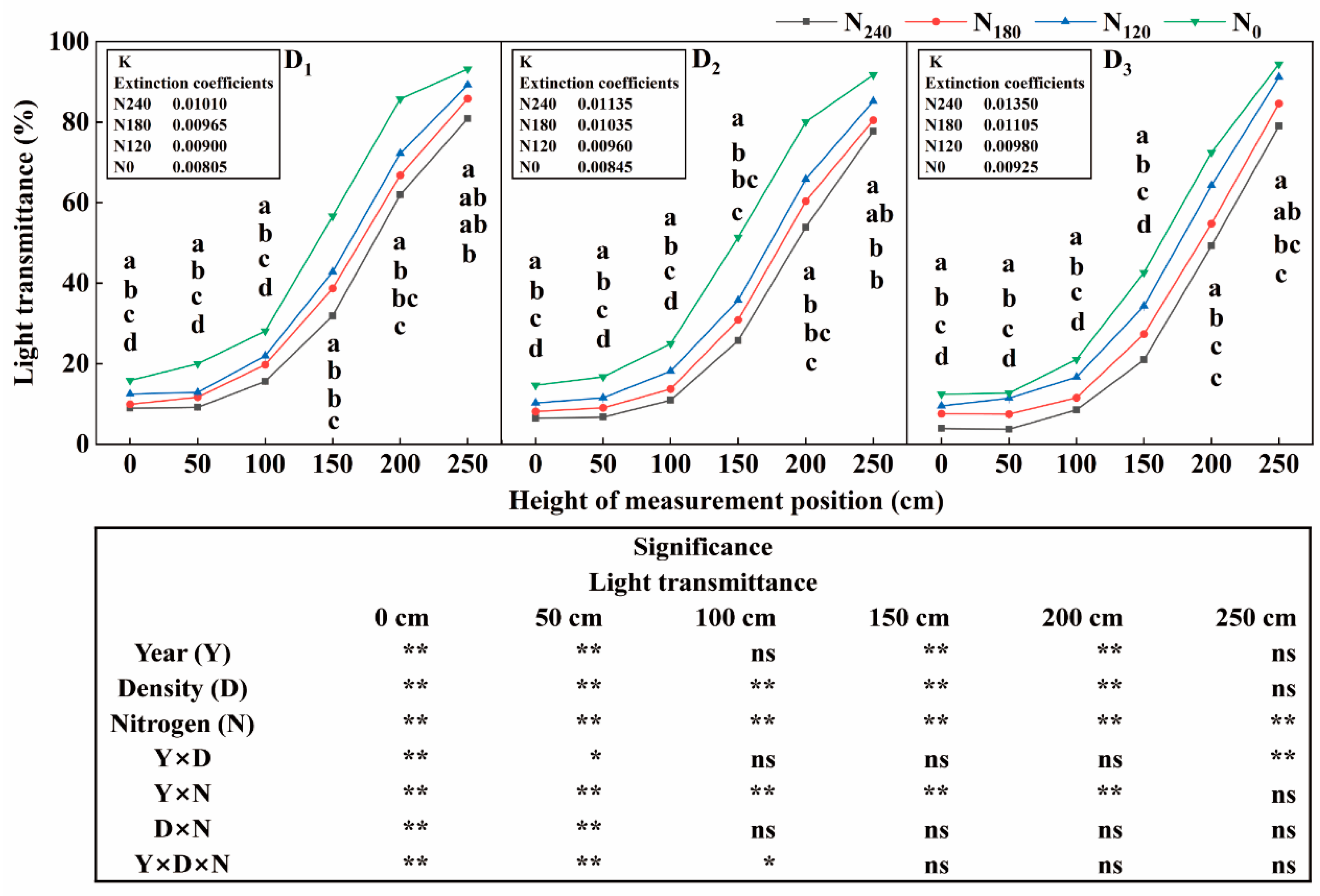
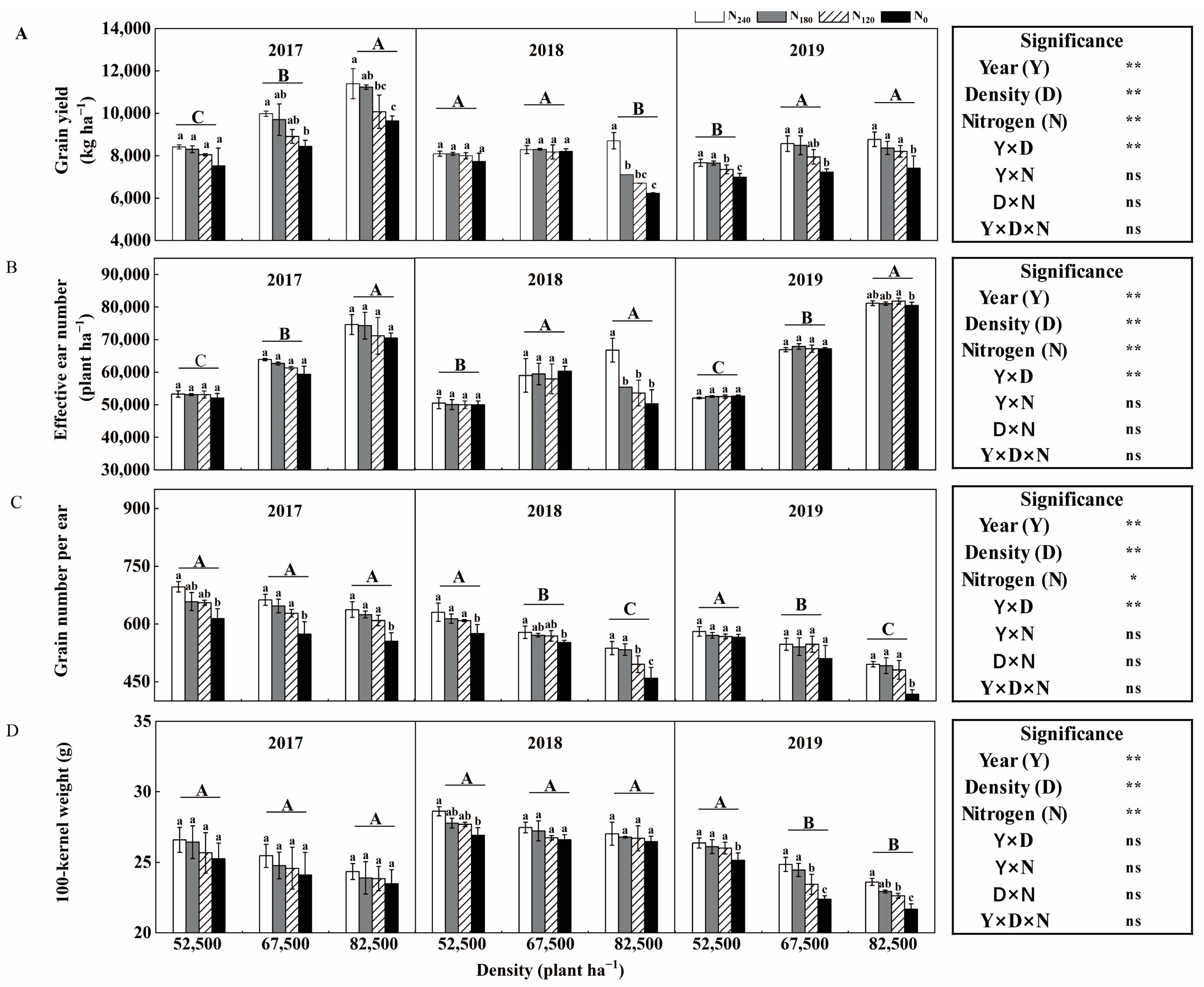
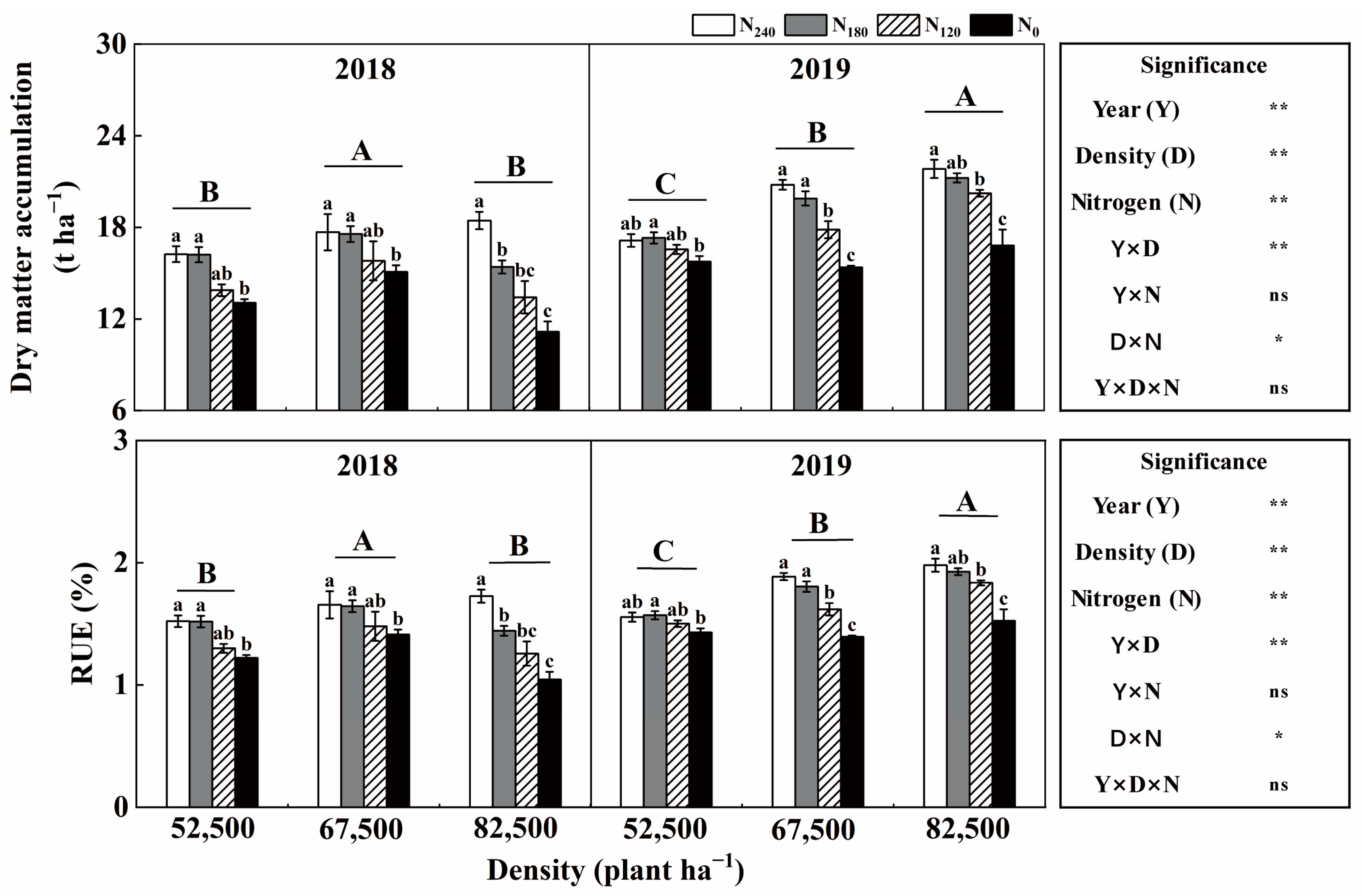

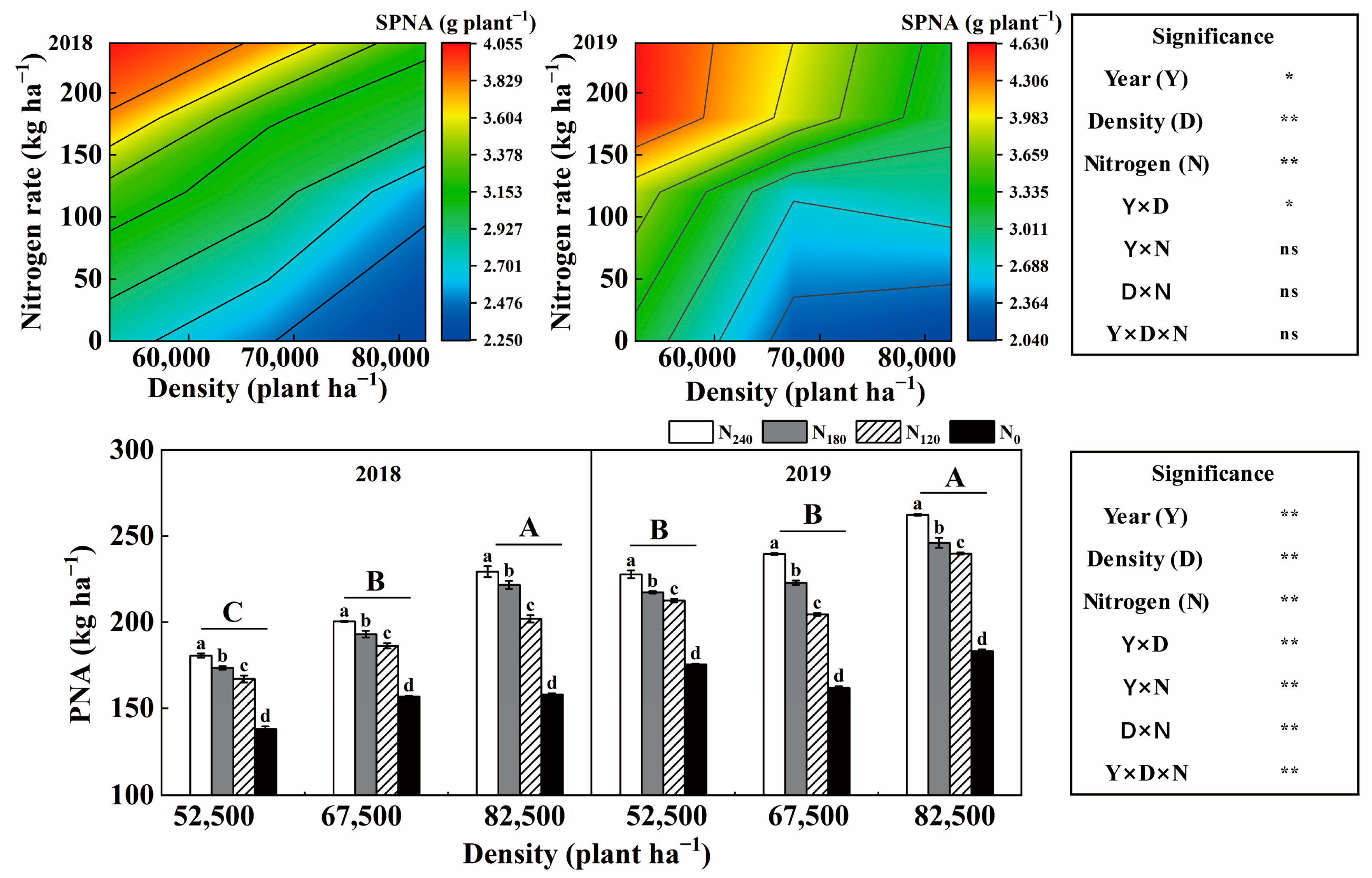
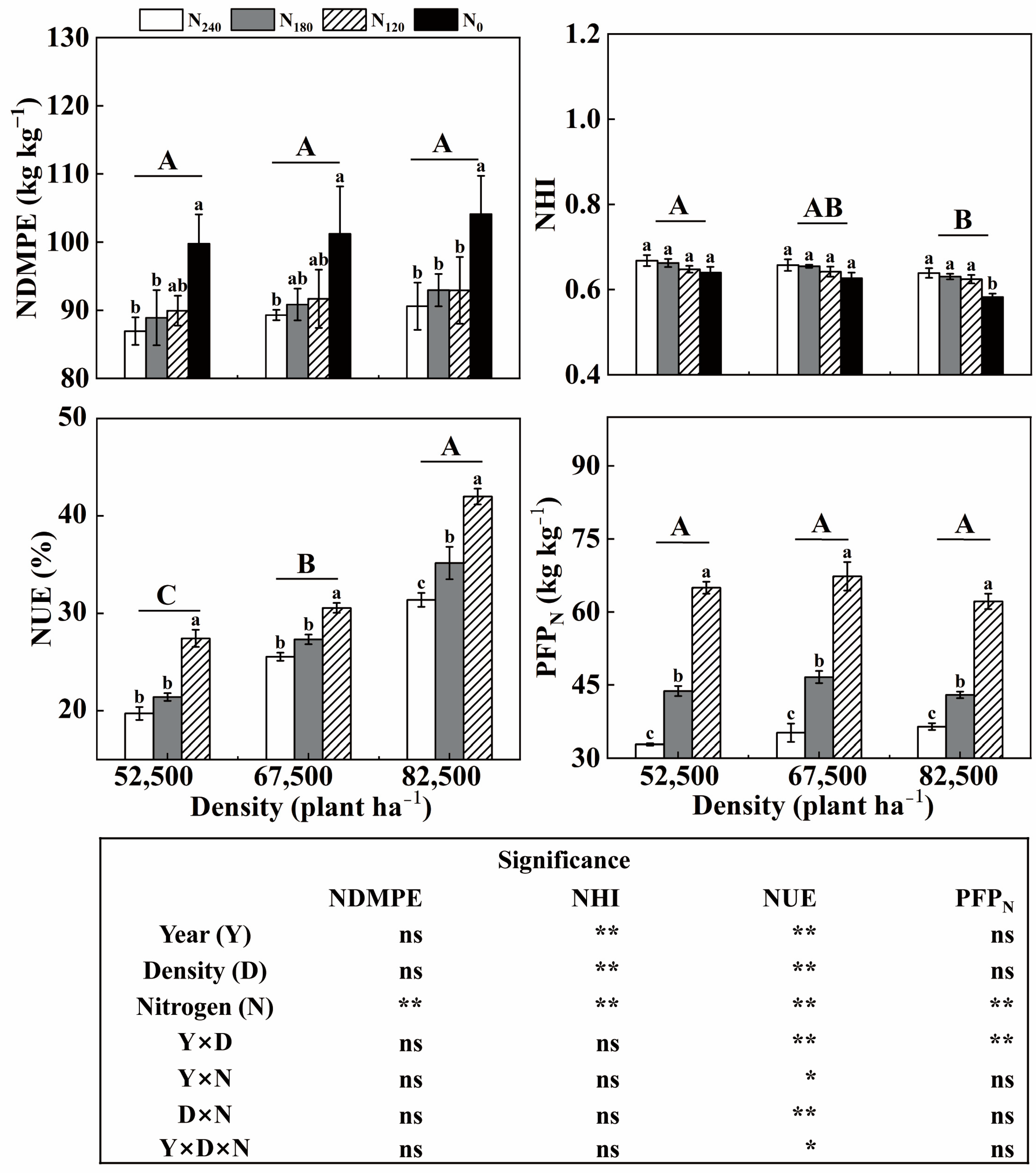
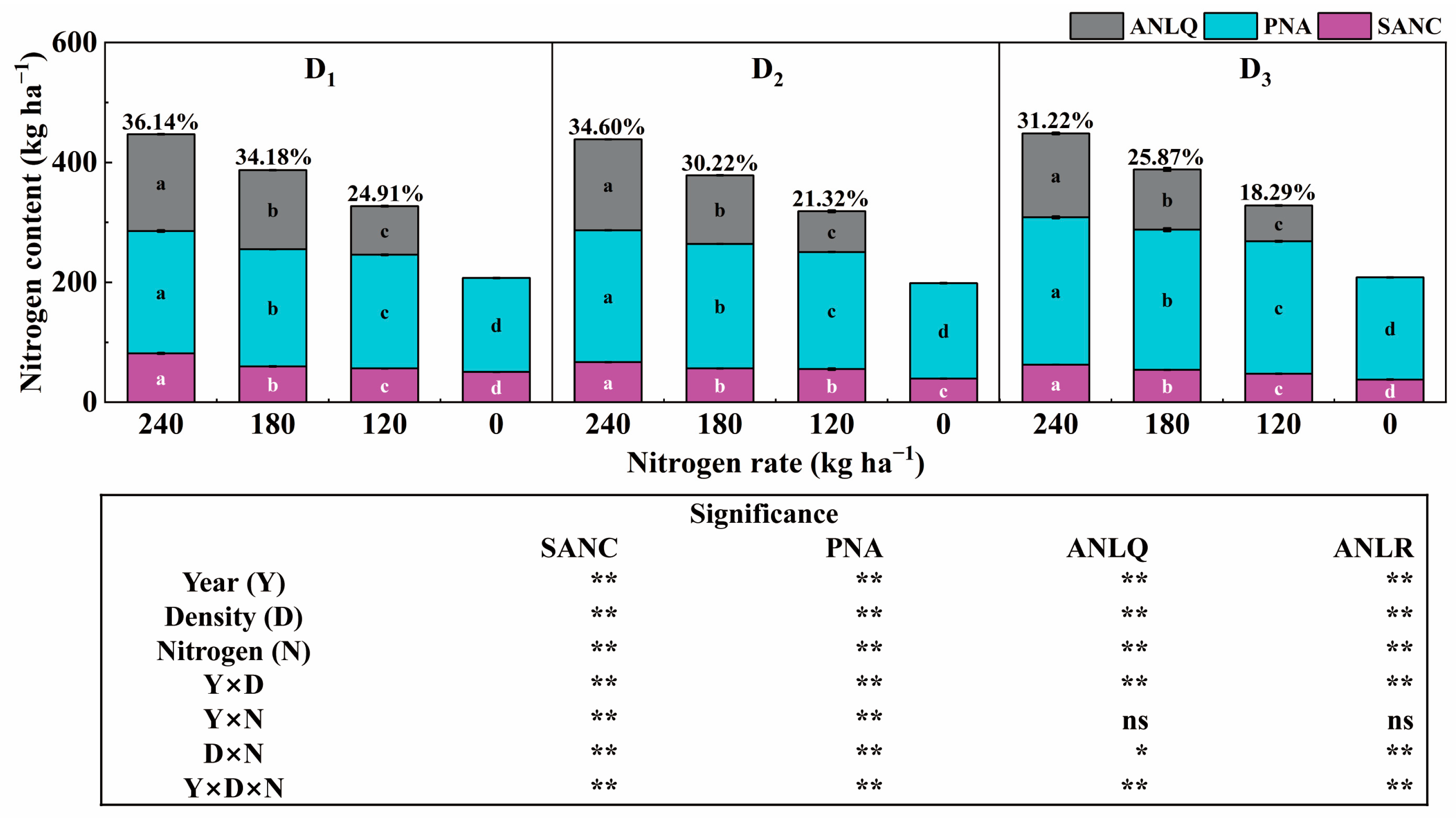
| Year | Solar Radiation (MJ/m2) | Average Daily Temperature (°C) | Total Precipitation (mm) |
|---|---|---|---|
| 2017 | 2015.5 | 26.6 | 410.7 |
| 2018 | 1869.4 | 26.5 | 1344.2 |
| 2019 | 1929.6 | 25.1 | 564.8 |
Disclaimer/Publisher’s Note: The statements, opinions and data contained in all publications are solely those of the individual author(s) and contributor(s) and not of MDPI and/or the editor(s). MDPI and/or the editor(s) disclaim responsibility for any injury to people or property resulting from any ideas, methods, instructions or products referred to in the content. |
© 2024 by the authors. Licensee MDPI, Basel, Switzerland. This article is an open access article distributed under the terms and conditions of the Creative Commons Attribution (CC BY) license (https://creativecommons.org/licenses/by/4.0/).
Share and Cite
Lei, H.; Zhou, F.; Cai, Q.; Wang, X.; Du, L.; Lan, T.; Kong, F.; Yuan, J. Effects of Planting Density and Nitrogen Management on Light and Nitrogen Resource Utilization Efficiency and Yield of Summer Maize in the Sichuan Hilly Region. Agronomy 2024, 14, 1470. https://doi.org/10.3390/agronomy14071470
Lei H, Zhou F, Cai Q, Wang X, Du L, Lan T, Kong F, Yuan J. Effects of Planting Density and Nitrogen Management on Light and Nitrogen Resource Utilization Efficiency and Yield of Summer Maize in the Sichuan Hilly Region. Agronomy. 2024; 14(7):1470. https://doi.org/10.3390/agronomy14071470
Chicago/Turabian StyleLei, Hao, Fang Zhou, Qianyi Cai, Xinglong Wang, Lunjing Du, Tianqiong Lan, Fanlei Kong, and Jichao Yuan. 2024. "Effects of Planting Density and Nitrogen Management on Light and Nitrogen Resource Utilization Efficiency and Yield of Summer Maize in the Sichuan Hilly Region" Agronomy 14, no. 7: 1470. https://doi.org/10.3390/agronomy14071470





